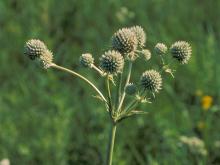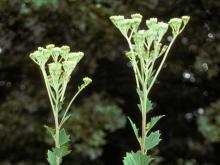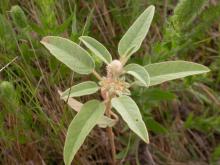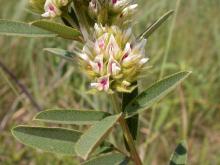Wildflowers, Grasses and Other Nonwoody Plants
Media

Species Types
Scientific Name
Polygonatum biflorum
Description
Solomon's seal grows statewide in moist, rich earth. The greenish-white flowers dangle like little bells beneath the leaves, under the gracefully arching stems.
Media

Species Types
Scientific Name
Euphorbia esula
Description
When you consider the negative effects this plant has on natural habitats, and how hard it is to control or eradicate, you almost want to rename it “leafy scourge”! This invasive plant is spreading in our state. Learn how to identify it.
Media

Species Types
Scientific Name
Asclepias viridis
Description
The flower clusters of green-flowered or spider milkweed bear large flowers for a milkweed. The jazzy purple hoods are dazzling against the greenish-yellow petals.
Media

Species Types
Scientific Name
Eryngium yuccifolium
Description
“It’s an odd plant,” this rattlesnake master, “with its leaves like yucca, a head like a thistle, and second cousin to the carrot.” That’s how the great prairie writer John Madson summed it up!
Media

Species Types
Scientific Name
Euphorbia commutata
Description
Conspicuous in early spring, wood spurge is a dainty species with loose clusters of small, light green flowers. Look for it in woods, valleys, streamsides, and waste areas in Ozark landscapes.
Media

Species Types
Scientific Name
Arnoglossum atriplicifolium (also Cacalia atriplicifolia)
Description
The stout, smooth leaves of pale Indian plantain, with their glaucous-white coating beneath, look almost artificial. They are irregularly shaped, with pointed lobes. At the base of the plant, they can be 6 inches wide. They become gradually smaller up the stem.
Media

Species Types
Scientific Name
Asclepias hirtella
Description
Prairie milkweed’s full, rounded clusters of small, delicately purple-tinged flowers set it apart from other prairie milkweeds.
Media

Species Types
Scientific Name
Croton capitatus
Description
Hogwort is fuzzy, densely covered with whitish hairs. A common but often overlooked plant in pastures, prairies, ditches, and roadsides, it’s usually less than 18 inches tall.
Media

Species Types
Scientific Name
Cuscuta spp.
Description
Dodders are easy to identify, even though at first you might not recognize them as plants. These parasitic plants usually look like a hairlike mass of yellow or orange, leafless, wiry, vining stems wrapping around the stems of other plants.
Media

Species Types
Scientific Name
Lespedeza capitata
Description
Round-headed bush clover is a stiffly upright plant that has rounded flower clusters with cream-colored, pea-shaped flowers with purple markings on the banner petal. It grows statewide in open habitats.
See Also
About Wildflowers, Grasses and Other Nonwoody Plants in Missouri
A very simple way of thinking about the green world is to divide the vascular plants into two groups: woody and nonwoody (or herbaceous). But this is an artificial division; many plant families include some species that are woody and some that are not. The diversity of nonwoody vascular plants is staggering! Think of all the ferns, grasses, sedges, lilies, peas, sunflowers, nightshades, milkweeds, mustards, mints, and mallows — weeds and wildflowers — and many more!





















